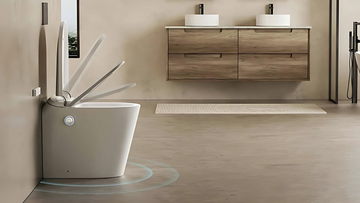For individuals with disabilities, using the bathroom can present a range of challenges that are often overlooked in standard restroom designs. However, with innovative toilet ideas for disabled users gaining attention, the landscape of bathroom accessibility is rapidly evolving to offer comfort, safety, and independence.
The concept of innovative toilet design is not just about technology but also about empathetic design that places the user's needs at the forefront. As we explore various solutions, it becomes clear that these ideas are transforming the way we think about inclusive design in the bathroom space.

Understanding the Needs of Disabled Users
The first step in creating innovative toilet ideas for disabled users is understanding the diverse needs and challenges these users face. Disabilities can vary widely, from mobility impairments to visual or cognitive challenges. Each type of disability requires specific considerations to ensure ease of use and accessibility.
For instance, individuals with mobility impairments may require additional space for maneuvering wheelchairs or walkers. They might also need support bars or grab rails to safely transfer from a wheelchair to the toilet. On the other hand, individuals with visual impairments might benefit from tactile surfaces and clear audio instructions.
Key Features of Innovative Toilet Designs
Modern toilet designs that cater to disabled users often include a range of features aimed at enhancing usability and safety. Some of these features include:
Height-Adjustable Toilets
Height-adjustable toilets allow users to modify the toilet's height to suit their specific needs, providing greater ease of use for individuals with varying mobility issues. This feature is essential for users who transfer from a wheelchair, as it minimizes the physical strain involved in the process.
Automatic Flushing Systems
Automatic flushing systems reduce the need for manual operation, which can be a significant challenge for individuals with limited dexterity. These systems are also beneficial for maintaining hygiene and reducing the spread of germs, as discussed in our self-cleaning toilet innovations article.
Bidet Integration
Toilets with built-in bidet functions offer enhanced hygiene and independence for users who may have difficulty with traditional cleaning methods. The ability to control water pressure and temperature can provide a more comfortable experience, as explained in our bidet integration blog post.
Incorporating Technology for Enhanced Accessibility
Technology plays a significant role in modernizing toilets for disabled individuals. Smart toilets equipped with sensors, automated functions, and voice-activated controls are becoming more prevalent. These features not only enhance convenience but also provide a dignified experience for users.
For example, voice-activated controls allow users to operate various functions of the toilet without physical interaction. This can include flushing, adjusting bidet settings, and even playing music or adjusting lighting for comfort.
Smart Toilets and IoT
The integration of Internet of Things (IoT) technology in toilet design is revolutionizing bathroom experiences. IoT-enabled toilets can offer personalized settings, track water usage, and even provide maintenance alerts. Learn more about these advancements in our article on water-efficient toilets.
Designing Inclusive Spaces for All
Creating accessible toilets is not just about adding features but also about designing inclusive spaces that accommodate everyone. This involves careful planning and consideration of all user needs to ensure that the bathroom is a welcoming space for all.
Public and private establishments are increasingly recognizing the importance of inclusive design. By adopting these innovative toilet ideas for disabled users, they are taking crucial steps toward a more inclusive society.
Conclusion
As we continue to innovate and improve toilet designs for disabled individuals, it is essential to focus on empathy, technology, and functionality. By understanding the unique challenges faced by disabled users and incorporating thoughtful design elements, we can create bathrooms that are accessible, comfortable, and empowering for all.
To read more about the future of bathroom technology, visit our insights on reinventing the toilet.

FAQ
What are some key features of toilets designed for disabled users?
Key features include height-adjustable toilets, automatic flushing systems, and bidet integration. These features enhance accessibility and independence for users with various disabilities.
How does technology improve toilet accessibility?
Technology such as smart toilets and IoT integration provides automated controls, personalized settings, and maintenance alerts, enhancing convenience and usability for disabled users.
Why is inclusive design important in toilet design?
Inclusive design ensures that bathrooms are accessible and comfortable for all users, regardless of their physical abilities. It promotes equality and independence for disabled individuals.
This article contains affiliate links. We may earn a commission at no extra cost to you.






